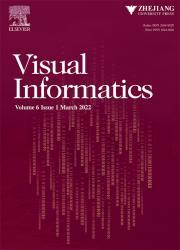VisMocap:多源动作捕捉数据的交互式可视化和分析
IF 3.8
3区 计算机科学
Q2 COMPUTER SCIENCE, INFORMATION SYSTEMS
引用次数: 0
摘要
随着人工智能的快速发展,计算机辅助人类实现智能增强,从而提高信息感知和处理的准确性和效率的研究一直在稳步发展。在这些发展中,人体动作捕捉技术的创新迅速涌现,导致动作捕捉数据类型的多样性日益增加。这种多样性需要为多源数据建立统一的标准,以方便对其表示人体运动的能力进行有效的分析和比较。此外,动作捕捉数据经常受到严重的噪声、采集延迟和异步的影响,这使得它们的有效处理和可视化成为一个关键的挑战。在本文中,我们利用从基于柔性织物的动作捕捉服装原型和光学动作捕捉设备中收集的数据作为输入。对两种数据类型进行时间同步和误差分析,对连续运动序列中的个体动作进行分割,并通过简洁直观的可视化界面呈现处理结果。最后,我们评估了各种系统指标,包括时间同步的准确性,从织物阻力到关节角度的数据拟合误差,运动分割的精度和用户反馈。本文章由计算机程序翻译,如有差异,请以英文原文为准。
VisMocap: Interactive visualization and analysis for multi-source motion capture data
With the rapid advancement of artificial intelligence, research on enabling computers to assist humans in achieving intelligent augmentation—thereby enhancing the accuracy and efficiency of information perception and processing—has been steadily evolving. Among these developments, innovations in human motion capture technology have been emerging rapidly, leading to an increasing diversity in motion capture data types. This diversity necessitates the establishment of a unified standard for multi-source data to facilitate effective analysis and comparison of their capability to represent human motion. Additionally, motion capture data often suffer from significant noise, acquisition delays, and asynchrony, making their effective processing and visualization a critical challenge. In this paper, we utilized data collected from a prototype of flexible fabric-based motion capture clothing and optical motion capture devices as inputs. Time synchronization and error analysis between the two data types were conducted, individual actions from continuous motion sequences were segmented, and the processed results were presented through a concise and intuitive visualization interface. Finally, we evaluated various system metrics, including the accuracy of time synchronization, data fitting error from fabric resistance to joint angles, precision of motion segmentation, and user feedback.
求助全文
通过发布文献求助,成功后即可免费获取论文全文。
去求助
来源期刊

Visual Informatics
Computer Science-Computer Graphics and Computer-Aided Design
CiteScore
6.70
自引率
3.30%
发文量
33
审稿时长
79 days
 求助内容:
求助内容: 应助结果提醒方式:
应助结果提醒方式:


